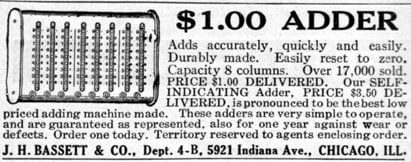The Bassett Adder was a continuous band adding machine that was invented by James Hunter Bassett. It was in production between 1909 and 1932 and was originally sold for just $1. There were two versions, with the second version being more complex and made from wood and tin. However, both worked by inserting a stylus into a hole and sliding it along a perforated band to add the numbers.
What Is The Bassett Adder?

After the disappearance from the market of Webb’s Ribbon Adder at the end of the 19th century, another similar device appeared with much better market success. The so-called Bassett Adder is another continuous band machine and was in production from 1909 till the end of the 1930s.
The device is a small, eight-positional adder with dimensions 10.8 x 7.5 x 2.2 cm and a weight of 80g. There were at least two models of the Bassett Adder. The first of these was made entirely of wood, paper, and celluloid. On this simple device, numbers are entered with a stylus by pulling down the perforated bands in each column. The user must pay attention, however. Every band has a black mark between each tenth hole. When pulling down a band using a hole above a black mark, one must remember to add one to the adjacent left column for the carry.
The second Bassett Adder is more complex. It has a wooden core with celluloid number bands, but it is encased in tin. The second device has an automatic feature to remind users to carry their tens — a red flag appearing in the column to the left signaling when it is necessary to carry.
Bassett Adder: History

The device was named after a manufacturer of adding machines — James Hunter Bassett (13 April 1888–1932) of Chicago, who produced and sold this device since 1909. In 1911 he advertised the device (see the nearby image) in Scientific American as the “Bassett $1.00 adder” sold by J.H. Bassett & Co. of Chicago. Some of the devices, produced by Bassett are inscribed Patent applied for or Patent pending, but Bassett never obtained a patent for this device (Charles Webb also had problems receiving patents for a similar device). Besides the company of Bassett, there were at least four other companies that manufactured and sold the device.
It was advertised in 1909 as “Clark’s New Adder,” a product of the Glenn C. Clark Manufacturing Co. of Chicago. In another ad from 1910, it is described as the “$1.00 ADDER,” sold by Commercial Specialities Agency of Chicago. In 1911, it was advertised by Timesaver Co., Chicago, under the name Speed. In the 1920s the device was sold by Johnson Smith & Co. of Racine, Wisconsin.
The image featured at the top of this post is ©Unknown author / public domain.
